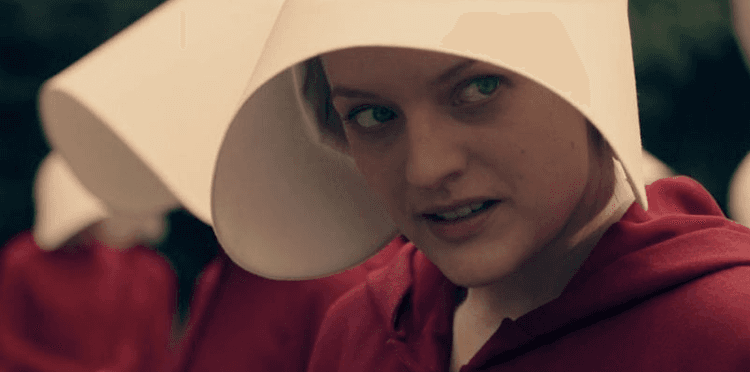Published in The Sydney Morning Herald in May, 2017.
It’s hard to imagine a book that resonates with our times as powerfully as The Handmaid’s Tale. Margaret Atwood’s cult 1985 novel tells the story of Gilead, an authoritarian, gender-segregated state that reduces fertile women, who aren’t allowed to read, write or own property, to “handmaids” – sexual slaves, forced to bear children for high-status men called Commanders. A series based on the 1985 novel about the life of a woman living in a dystopian world where she is meant a have a child for a powerful family.
And since Donald Trump’s election last November, this soon-to-be TV series has felt less like a fictional dystopia and more like a glimpse at what’s possible once the freedoms we take for granted slip away one by one, like beads on a bracelet.
In late April, the miniseries adaptation of The Handmaid’s Talestreams on Hulu and stars Elisabeth Moss as Offred, the once-brazen protagonist who’s been stripped of her former identity. (Offred is the patronym “Of Fred”, the Commander who attempts to impregnate her). In February, The Handmaid’s Tale joined George Orwell’s 1984 at the top of Amazon’s best-seller list. And in March, a group of women wore its iconic red robes and bonnets to protest an anti-abortion bill that passed through the Texas senate.
“Anything can happen anywhere, given the right circumstances,” Atwood warned back in June 2015.
1. Offred’s lack of bodily autonomy invokes modern-day anti-abortion laws
In the world of The Handmaid’s Tale, women’s lives are only contingent on their ability to produce babies and a group of rich, religious white men decide the fate of female bodies. The Commander has perfunctory sex with Offred, held down by his wife, Serena Joy, who can’t get pregnant, and the women are rounded up to watch a handmaid called Ofwarren, who’s bullied for having an abortion, give birth. Sure, it sounds absurd — until you remember that we live in a culture in which a Texas judge recently referred to pregnant women as “hosts”, abortion is still a criminal offence in Queensland and New South Wales, and the Australian Christian Lobby is fighting to reinstate the global gag rule which denies women from Pacific Island nations rights to reproductive health services and abortion access.
The Handmaid’s Tale takes the culture’s motherhood fetish to its chilling endpoint and reminds us that we need to fight for autonomy over our lives and bodies at every turn.
2. Victim-blaming in Gilead echoes the way we perpetuate rape culture
The Handmaid’s Tale might be speculative fiction but is written in the hushed, intimate cadence of a best friend’s diary, something that makes the hard-to-read moments difficult to absorb. Near the start of the book, a character called Janine confesses to being gang-raped at 14, as the Handmaids chant “her fault, her fault, her fault!” and “teach her a lesson, teach her a lesson, teach her a lesson.”
More than 30 years before a 16-year-old girl received death threats after being sexually assaulted by highschool football players from Steubenville, and Brock Turner was convicted of sexual assaultand served just three months of a jail sentence, the book exposes the way our culture holds female victims responsible for male crimes and anoints women the gatekeepers of men’s sexual impulses. Atwood, who famously collated newspaper clippings of real-life crimes while researching the novel, shows us how easy it is to be complicit.
3. Serena Joy symbolises the way complicit women uphold the patriarchy
With the exception of Offred’s lover Nick, the men in The Handmaid’s Tale are despicable, composites of the worst aspects of masculinity. But Atwood also shows how women who’ve swallowed the patriarchy’s messages use misogyny to coerce and control.
In Gilead, Aunts, the highest class of women, indoctrinate the Handmaids with Bible readings and sermons and teach them to uphold morality and purity while Serena Joy, a homemaking advocate who’s neither serene or joyous, calls Offred a slut (her character was inspired by Phyllis Schlafly, the Californian conservative activist who repealed the Equal Rights Amendment). She’s also a prototype for conservative women like Pauline Hanson, an ardent anti-feminist who, in a February 2017 Guardian report, proposed cuts to paid parental leave because “women will get themselves pregnant”.
4. Offred’s life as a handmaid recalls the plight of women in surrogacy hostels
During January’s Women’s March, protesters held up signs that read “Make Margaret Atwood Fiction Again”. That the book is read as fiction, a cautionary tale for middle-class white women who don’t agitate for their personal freedoms, often overshadows the fact that many women of colour have firsthand experience with Offred’s life.
As Victoria Smith writes in New Statesman, fertility agencies often use the term “host” to refer to the women in India’s surrogacy hostels who, driven by poverty, rent their wombs to Western women. And Offred, whose five-year-old is taken away from her before she’s captured, suffers a fate that’s unthinkable for any mother but one that’s familiar to Aboriginal women who were part of the Stolen Generation.
The Handmaid’s Tale is essential reading because we can learn from its dystopian vision, yes. But maybe it owes its true power to its ability to show us just how selective this vision can often be.
